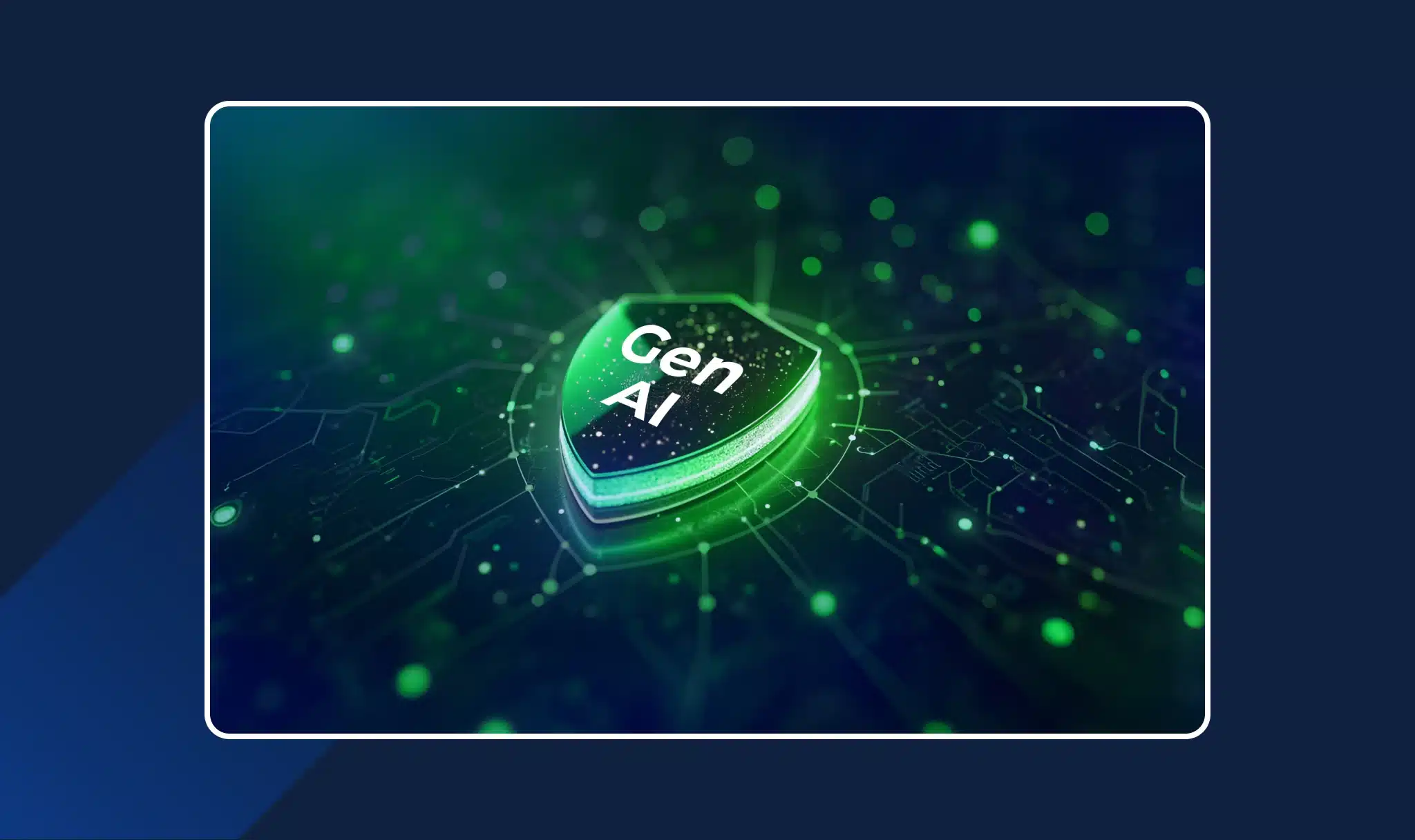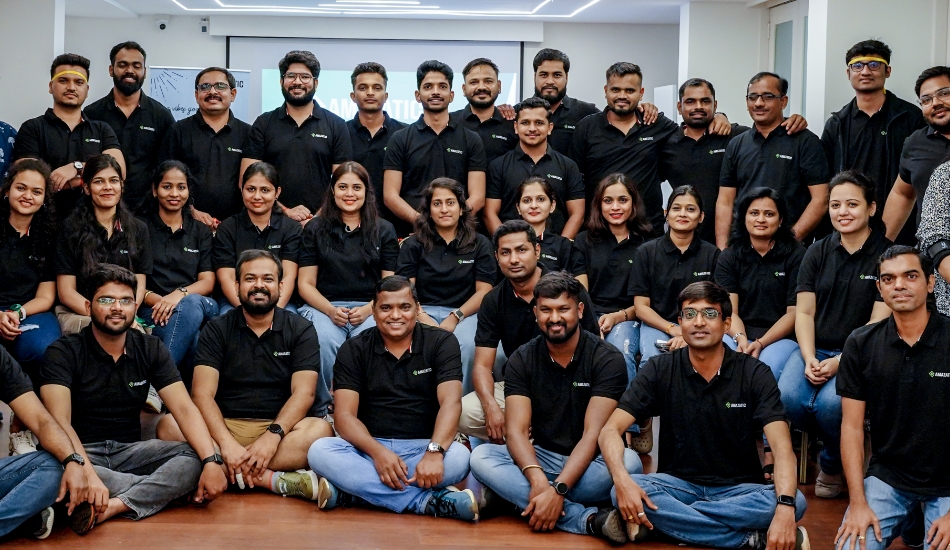Generative AI isn’t just hype anymore—it’s embedded in enterprise workflows. In the US, more than 95% of enterprises are already using GenAI across functions—from code generation and marketing to finance and HR. Adoption is exploding, and productivity gains are real: engineering teams save 5–10 hours a week, marketers launch campaigns 30% faster, and support teams resolve tickets up to 40% quicker.
But there’s a catch. The same tools that accelerate work also raise serious risks: data leakage, bias, regulatory violations, and unpredictable model behavior. So the question isn’t “Should we slow down to stay safe?” The real question is, “How do we establish AI guardrails that let us move fast because we’re safe?”
What “Safe GenAI” Actually Means
Safety in GenAI isn’t a single lock on the door. It’s an approach rooted in enterprise AI governance that spans multiple areas:
- Data security: Protect sensitive business or customer information from leaking in prompts or outputs. Even accidental exposure of PII or proprietary code can trigger multimillion-dollar breach costs.
- Model reliability: Ensure outputs are accurate and consistent, not hallucinated guesses that could mislead decision-makers.
- Misuse resistance: Harden systems against adversarial attacks like jailbreaks or prompt injection, which are common risks in GenAI risk management.
- Fairness and compliance: Satisfy laws like HIPAA, CPRA, and NYDFS while avoiding discrimination or bias in decisions that affect people.
- Auditability: Maintain clear logs and reporting so responsible AI adoption can be proven to regulators, customers, and leadership.
Safe GenAI means predictable, explainable, and defensible outputs—something every enterprise leader can trust.
The False Trade-Off: Trust Doesn’t Mean Slowness
Some leaders still assume safety slows down AI for enterprise. Manual reviews, long approval cycles, and bureaucratic processes once made that true.
But modern GenAI governance models flip the script. Policy-as-code, AI gateways, and pre-approved blueprints have cut cycle times by 40–60%. In procurement, GenAI-powered intake management has halved approval chains. In automotive, regulatory approvals that took months now finish in weeks.
The message is clear: when AI guardrails are built into the pipeline, teams actually ship faster while staying compliant.
The Risk Landscape: What Enterprises Face
If you’re deploying AI for enterprise, here’s what should be on your radar:
- Data leakage: Uncontrolled exposure of sensitive data is the most expensive risk, with breach costs in the US averaging $9.8M.
- Jailbreaks: Skilled human-led jailbreaks succeed more than 70% of the time when defenses are weak.
- Shadow AI: Employees using unauthorized tools put intellectual property and compliance at risk, especially in regulated industries.
- Regulatory scrutiny: States like California and Colorado now demand transparency, explanations of AI decisions, and consumer opt-out rights.
- Sector-specific obligations: HIPAA governs healthcare, GLBA and NYDFS regulate finance, and frameworks like NIST AI RMF set the tone for enterprise AI governance.
These aren’t hypothetical risks. Between 2023 and 2025, US enterprises saw multiple real-world prompt injection incidents—Microsoft 365 Copilot leaks, Azure OpenAI jailbreaks, and healthcare bots exposing PHI.
Guardrails That Actually Work
So how do enterprises embrace responsible AI adoption without slowing down? The answer lies in a few proven guardrails:
- Data & Privacy Controls: PII detection, redaction, and de-identification pipelines ensure sensitive information never makes its way into the model. This helps compliance and preserves trust.
- Security Gateways: An AI gateway acts like a firewall, handling authentication, anomaly monitoring, and output filtering before responses are released.
- Evaluation Harnesses: Automated test frameworks assess hallucination rates, jailbreak resilience, and toxicity before deployment, making GenAI safer from day one.
- Red Teaming: Structured attack simulations every few months expose vulnerabilities so they can be patched proactively.
- Policy-as-Code: By encoding governance rules into pipelines, enterprises enforce enterprise AI governance automatically rather than relying on manual checks.
- Retrieval Security: In RAG systems, row-level access controls prevent sensitive knowledge bases from being overexposed.
Making Speed the Default
Enterprises leading in GenAI risk management see safety as part of the design pattern, not an afterthought:
- AI gateways centralize enforcement, eliminating the need for every team to reinvent controls.
- Pre-approved blueprints streamline use cases like support bots or marketing assistants, allowing faster rollouts without endless review cycles.
- Guardrail stacks combine input sanitization, policy enforcement, and output validation into one seamless flow.
- Human-in-the-loop triggers are reserved for high-risk decisions like medical or legal advice, keeping oversight strong without slowing routine tasks.
That’s why JPMorgan cut contract review time by 40% and Capital One sped up fraud response by 25% while staying compliant.
Who Owns What
Strong enterprise AI governance requires clear ownership across functions:
- Product teams define use cases aligned with business needs.
- Security implements and monitors AI guardrails.
- Data teams manage access scopes to sensitive information.
- Legal/Privacy translate regulations into enforceable policies.
- MLOps/Platform maintain pipelines, logs, and monitoring for safety assurance.
When responsibilities are shared and reviewed regularly, governance shifts from being a roadblock to being an enabler.
Building Safe GenAI: A Practical Roadmap
Safe AI for enterprise isn’t about fixed timelines—it’s a maturity journey.
- Foundations: Deploy security gateways, define acceptable use cases, and protect sensitive data at the source. Assign clear ownership across security, data, and legal so governance is embedded from the start.
- Integration: Bake safety into workflows with policy-as-code in CI/CD, automated evaluation harnesses, and standardized blueprints for common use cases. Link safety KPIs directly to performance dashboards.
- Continuous Assurance: Run red-teams regularly, monitor hallucination and leakage rates in real time, and adjust controls to meet evolving laws like CPRA or Colorado’s AI Act. Build a culture where safety is seen as part of responsible AI adoption, not an obstacle to it.
This roadmap builds trust while enabling speed. Each stage reinforces the next, turning safety into a growth engine.
Measuring “Safe + Fast”
To prove that GenAI safety measures work without slowing down, enterprises track:
- Safety incident rate: Flagged unsafe outputs per thousand queries, often kept under 5 with strong filters.
- Approval cycle time: Time from request to production, shrinking to 3–10 days with automated governance.
- Resolution time for incidents: Aiming for fixes within 24–72 hours of detection.
- Hallucination rates: Targeting factual correctness above 95% on benchmark datasets.
- PII leakage rate: Monitoring with automated detectors to achieve near-zero exposure.
These KPIs aren’t just compliance checks—they’re evidence that AI guardrails help enterprises move quickly and safely at the same time.
Safe GenAI isn’t a brake on speed—it’s the fuel that keeps adoption sustainable. US enterprises already show that with the right GenAI risk management, approval cycles shrink, decision latency improves by 30–50%, and employees save hours every week.
The lesson is simple: don’t treat safety as overhead. Treat it as the enabler of responsible AI adoption and the reason you can scale AI for enterprise confidently.
Want a starting checklist? Build your gateway, codify your policies, measure your KPIs, and red-team often. That’s how you build trust without losing momentum.


